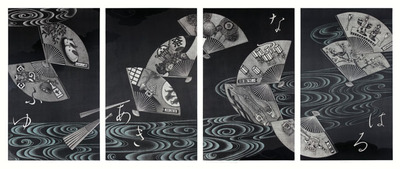HANGA NOW:CONTEMPORARY JAPANESE PRINTMAKERS

Hamanishi Katsunori, Japanese Classic Calendar, 2015, quadriptych
mezzotint printed in color, each panel measures 59.6 x
36.1 cm. Art Museum, University of Saint Joseph, purchased
with a gift from Edwina Bosco ’50, 2016.
“Hanga” is the Japanese word for “print.” Thus the title, Hanga Now, for the upcoming exhibit in the gallery at the University of St. Joseph, that explores the state of contemporary Japanese printmaking.
This survey of approximately 75 pieces by some of Japan’s major contemporary printmakers, as well as a number of emerging artists, reflects the great magnitude of the art form today. The show offers an understanding of how printmaking evolved from a traditional craft of woodblock prints that were created collaboratively between the artist, carver, printer and publisher, to a more creative and eclectic one in which individual artists design, create and print their own works.
Illustrating the diversity and global reach of the medium, this exhibition exemplifies the full scope of today’s printmaking techniques, ranging from the traditional woodblock process to lithography, etching, mezzotint, screenprint, photography, embossing and collagraph.
Many of the artists in this show deal with time-honored themes in an exciting new way. They are at once open to the world and pushing boundaries, while simultaneously retaining aspects of a familiar Japanese aesthetic—finding a meeting place at the intersection of tradition and innovation.
Shinichi Nakazawa, for example, uses an etching technique with blocks of gold overlay, bringing a centuries-old practice to a modern conclusion by contrasting references to Japanese calligraphy against a contemporary abstracted field.
In her image of Mt. Fuji, Reika Iwami, the first Japanese female print artist to achieve the same recognition as male artists, uses the customary woodblock process—stressing the character of the wood grain itself—to create a modern composition of a traditional subject. Ryohei Tanaka contemporizes a traditional pastoral winter scene with abstract surface patterning.
Susumu Endo, probably as contemporary and removed from Japanese tradition as these artists get, manipulates lithography with photography to achieve an ethereal quality in which abstracted light becomes the primary element, arriving at a uniquely futuristic image.
This is a thoughtful exhibition that appeals to both the eye and the mind, at once beautiful to observe, while concurrently prompting one to consider various aspects that influenced the development of contemporary Japanese printmaking.
